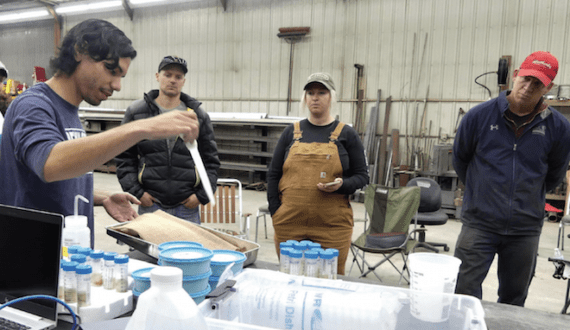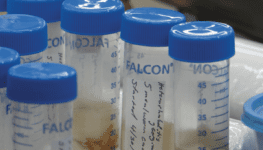

Jul 8, 2021Nematode ‘ranching workshop’ helps cranberry growers
A workshop for Wisconsin cranberry growers interested in raising nematodes to help control red-headed flea beetles and other insect pests on their marshes was held recently on the Pergande Cranberry Marsh north of Warrens, Wisonsin.
The two-hour program was led by Shawn Steffan, a USDA Agricultural Research Service entomologist and associate professor with the University of Wisconsin (U-W) Department of Entomology, and Brandon Gominho, a USDA-ARS technician working in Steffan’s lab.
The May 6 workshop attended by eight cranberry growers was facilitated by Allison Jonjak, University of Wisconsin-Extension cranberry outreach specialist, and Pam Verhulst, co-owner of the cranberry crop scouting service Lady Bug IPM.
Working with a team of interested cranberry growers and crop scouts in 2020, Steffan and Gominho looked at various methods to propagate the insect-killing nematodes on a scale that growers could use as a bioinsecticide on their marshes.
“We had several setbacks, but we also had some significant successes last year in raising nematodes on a larger scale. And we generated some of our best data yet on flea beetle control with nearly 95% control in a bed that had major flea beetle issues. Other cranberry beds had modest but solid control ranging from 50% to 60% control. Timing of applications is the key,” Steffan said.
Steffan began studying native nematodes seven years ago with former Ph.D. student Shane Foye.
Steffan and Foye, who has since graduated with his doctorate in entomology from UW-Madison, hypothesized that nematodes with the ability to control cranberry insect pests must exist in the wild marshlands of Wisconsin.
“In every ecosystem you have native plants, you have native herbivores, and you also have native carnivores. So, we thought surely there are very specific natural enemies of the insect pests of cranberries, because that’s just how nature works,” Steffan said.
Foye had previously studied nematode ecology while working on his master’s degree at Oklahoma State University, so when he joined the Steffan Lab in 2015, he and Steffan began looking for native nematodes among populations of wild cranberries growing in central Wisconsin.
In their search, they found two species of nematodes native to Wisconsin – Oscheius onirici and Heterorhabditis georgiana – that showed promise in controlling certain cranberry insect pests, including red-headed flea beetles.
As with all entomopathogenic nematodes – which are small, translucent roundworms – O. onirici and H. georgiana invade insect hosts in order to complete its life cycle, killing the host in the process.
In field studies, Foye treated 2-foot by 6-foot caged plots with the two species of nematodes. While the control plots had an average of four flea beetles per square foot, the nematode-treated plots had an average of just 1.1 flea beetles.
During their farm-scale efficacy trials in 2018, Steffan and Foye examined if cranberry growers could modify their boom sprayers to help improve the nematodes survival rate. While active when put into the sprayer tank, many of the nematodes collected after they came through the boom’s spray nozzles were traumatized, Steffan said.
“Basically, the nematodes come out the other end of the nozzles all dazed and confused,” Steffan said.
Steffan and Foye found that simply removing the spray nozzles and screens from the sprayer boom solved that problem. The nematode-treated beds in the 2018 study had an average of 45% fewer flea beetles than the control beds.
One cranberry grower even built a gravity fed nematode sprayer, allowing for low-trauma applications of nematodes which are about the size of a piece of lint.
Steffan also found the survival rate of the nematodes is improved if growers irrigate before, during and after applying the nematodes to help wash them down through the plant canopy and into the soil. He also suggests making the application at dusk as sunlight is harmful to the soil-dwelling nematodes.
“When we attend to the basic needs of the nematodes, this bioinsecticide has the potential to be a replacement for one – possibly two – insecticide sprays, depending on the efficacies of those sprays,” he said.


At the end of the workshop, attendees were sent home with two test tubes (one each of O. onirici and H. georgiana), along with petri dishes and cotton rounds to start propagating nematodes to apply on their own cranberry marshes. Gominho advised allowing at least three weeks to grow a sufficient number of nematodes to apply.
Gominho demonstrated the process he uses for rearing nematodes and provided a list of suggested materials, which included such items as metal paint trays, rolls of burlap, a microscope, a turkey baster and mealworms which serve as the food source for the nematodes.
While the two species of nematodes work well together, Gominho explained that it important to keep them separate as much as possible while rearing them. Initially, Gominho places a few mealworms in a petri dish on a moistened cotton round to which he adds nematodes and then covers with a second wet cotton round.
“Think of it as a nematode slider with the two cotton rounds being the bun,” Gominho said. “Nematodes are soil dwellers, so you don’t want to add too much water. You just want to saturate the cotton and have a little pool of water in the bottom of the petri dish.”
To gear up production, Gominho transfers the nematodes grown in the petri dishes into metal paint trays lined with two pieces of burlap. The burlap is porous enough to allow the nematodes to be easily removed, while also retaining moisture to keep the mealworms moist. Using a turkey baster, Gominho wets the burlap three times a week.
To produce the volume of nematodes Gominho is seeking, he uses a mobile tray cart like those used in a school cafeteria and 18-inch by 24-inch baking pans. The pans are large enough to hold two of the metal paint trays, which Gominho covers with cafeteria trays to reduce light and retain moisture.
The nematodes prefer a dark, warm location so Gominho suggested cranberry growers put their nematode rearing trays in a shop building that is heated and cover them with black plastic or place them a storage cabinet.
Gominho also demonstrated how he estimates the number of nematodes he has produced. After collecting the “nematode slurry” from the paint trays into a beaker, Gominho uses a small syringe to place one-tenth of a milliliter of the slurry onto a microscope slide that has a grid to allow him to count the miniscule round worms with a compound microscope.
Gominho’s goal is to raise enough nematodes to apply 6.2 million nematodes per acre or about one nematode per square inch of soil.
Rather than trying to produce enough nematodes to cover an entire cranberry marsh, Steffan said growers might want to target beds with higher levels of flea beetles or spray “hot spots” within a bed.
In addition to flea beetles, the nematodes have also shown good results in controlling other cranberry pests, including sparganothis fruitworm and cranberry girdler larvae, as well as white grubs, fruit flies and mosquitoes.
Steffan and Gominho will be gathering additional data from field trials undertaken this season. The pair are also working on developing rearing methods that a commercial company could use to produce nematodes for cranberry growers who prefer not to attempt rearing them themselves.
— Lorry Erickson, FGN correspondent.
Top photo: Wisconsin cranberry growers Gabriella Liddane, David Zawistowski, Amber Bristow and Mike Gnewikow look on as USDA Agricultural Research Service technician Brandon Gominho demonstrates the steps for rearing nematodes shown to kill cranberry insect pests. They were among the eight cranberry growers who attend a “Nematode Ranching Workshop” held in May. Photos: Lorry Erickson














